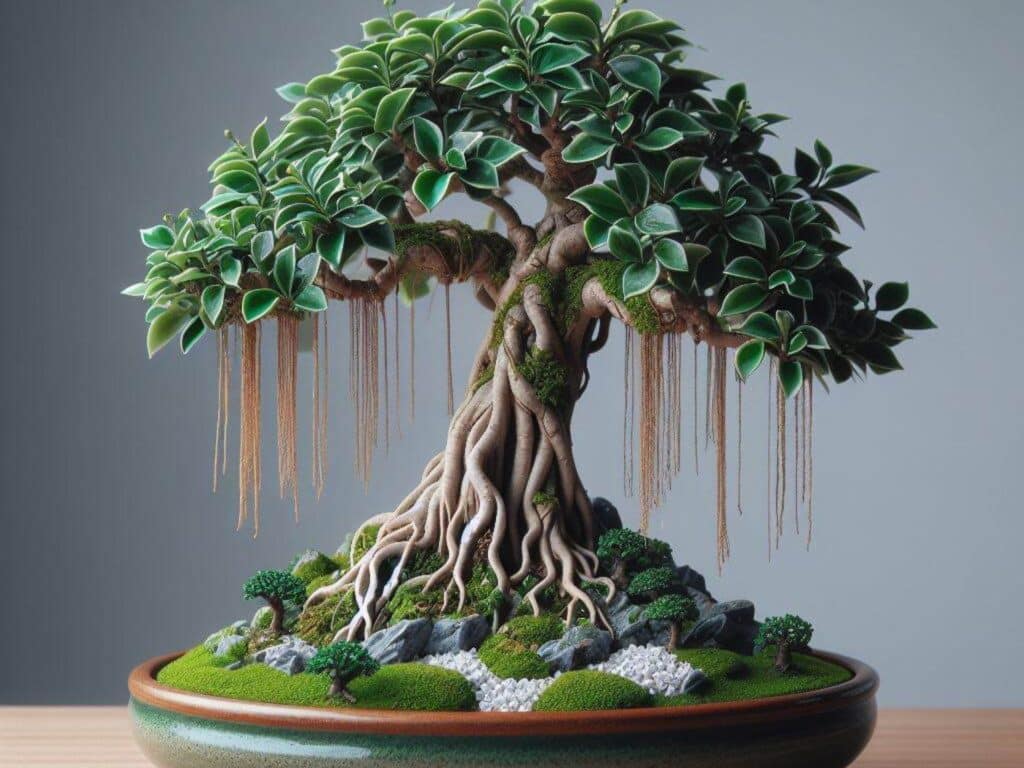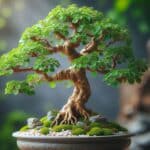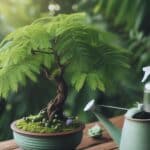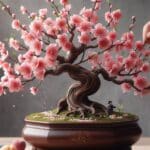The banyan tree is a bonsai lover’s dream plant because it is one of the easiest plants to bonsai; it doesn’t require much maintenance and will grow well in indoor environments with just a little bit of indirect light.
This incredible tree species, the curtain fig or ficus ginseng, is a tree in the fig family Moraceae. It is one of the most popular plant species used for bonsai creations and one of the very best plants for bonsai beginners.
If you want a bonsai tree that is effortless yet beautiful then this is the right plant species to start with and in this guide, we will show you exactly how to grow this charming bonsai type.
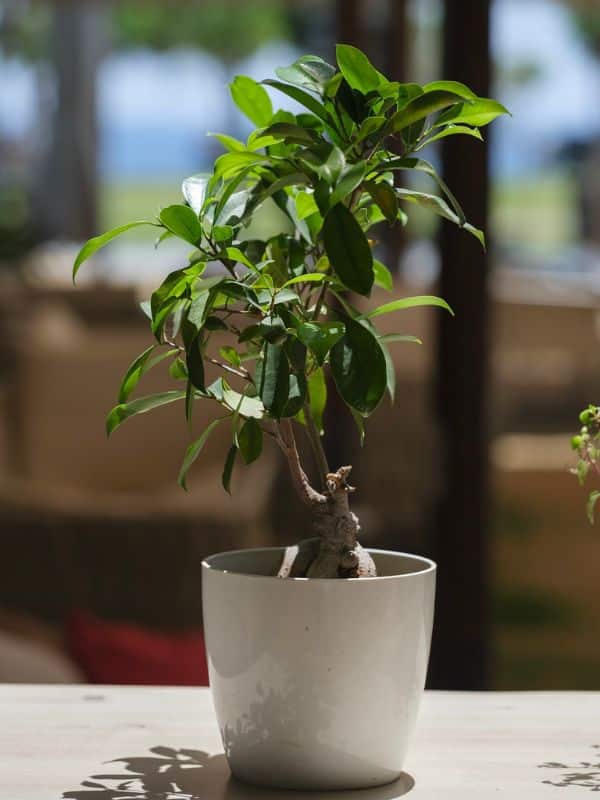
Plant Facts
| Scientific name | Ficus benghalensis |
| Common names | Banyan fig, Indian banyan fig, or Chinese banyan tree |
| Family | Moraceae |
| Plant Type | Tropical tree |
| Height and Width | 100 ft. tall (natural), 5 – 10 ft. tall (bonsai) |
| Origin | Native to India |
| Flower colors | Yellow |
| Foliage color | Light to dark green |
| Sun Exposure | No more than 6 hours per day |
| Soil Type & pH | Well-drained with organic matter (peat moss, perlite and sand) |
| Special features | Low Maintenance, Good for for containers, creates beautiful areal roots, easy to grow. |
What Does a Bonsai Banyan Tree Look Like
Most banyan tree bonsai are wider than tall, have expansive canopy, often have multiple trunks, and form many branches. Many areal roots are expected to droop down from trees into the soil. The foliage of these plants is glossy with a dark green hue, and the structure can look different for different varieties.
Where Does Banyan Tree Bonsai Grow
These small trees can be very hardy and are suitable for indoor or outdoor environments. Indoors, the plant should be kept where it will get lots of indirect sun and some direct early morning sunlight is ideal. Outdoors, these plants should be placed in partial shade and protected from scorching direct sunlight.
How to Grow a Banyan Tree Bonsai
The banyan tree is a favorite among bonsai artists because it is effortless to grow and care for. They are also quick to establish and can start to look like a bonsai within just two years.
The stems of these trees (especially the Chinese banyan) naturally tend to thicken up quickly, giving your tree a more aged appearance. Let’s look at how to create this miniature tree from the start.
Propagation
The easiest way to propagate a banyan tree is from cuttings. Cuttings will produce roots pretty quickly but less fast than ficus racemosa or ficus religiosa. The plants can also be grown from seed, but it is easier to develop them from cuttings since the cutting will give you a huge head start.
To grow a banyan tree from cuttings, you first need to take some cuttings from the tips of branches. The cuttings should be clipped off about an inch below and above a leaf. Dip the cutting in rooting hormone and plant it in moist soil. The soil should be kept moist until roots develop. This usually happens within just a few weeks.
Soil
Banyan trees are pretty hardy and can grow well in a basic soil mix. Once planted in a bonsai pot, you should establish it in a well-drained soil mix. Any bonsai soil mix that is rich in organic matter should work just fine. You can also create your own bonsai soil by mixing equal parts of peat moss, perlite, and sand.
Pruning
Pruning is important for shaping your Chinese or regular banyan tree and keeping it nice and small. It is best to prune these trees in spring or early summer when the new growth has hardened.
Use clean pruning shears to clear away any dead or diseased branches. Next, remove unwanted extensions that don’t match the bonsai shape you are trying to create.
A banyan bonsai can be pruned throughout its growing season, but be careful to remove only a little foliage, or these trees can start to struggle.
Aluminum or copper bonsai wire can also be used to modify some of the tree’s branches into a more suitable shape.
While pruning your tree, you should be careful not to damage the areal roots. These tend to grow down from the branches and can give the trunk a unique appearance. The areal roots can also be pruned and shaped to give the tree a more exciting look. For example, some like to wrap the areal roots over rocks to create an attractive over-the-rock design.
Repotting and Transplanting
These bonsai trees should be repotted every two to three years. This will keep the roots from becoming pot-bound and help keep the tree small.
Selecting and preparing your bonsai container before transplanting the tree is best. These trees prefer a flat container with lots of drainage holes.
Carefully remove the tree from its container and use a root rake to loosen the dirt around the roots. You can now trim away any diseased or overly large roots. About one-third of the root system should be removed.
After trimming, the tree can be planted with fresh soil, watered, and kept moist until the roots recover.

How to Care for Banyan Bonsai Trees
One of the main advantages of these trees is that they are so easy to maintain. Let’s look at how to keep ficus trees alive after planting them inside a bonsai pot.
Water
These tropical trees need regular watering. Banyan tree bonsai prefer deep watering but you should wait for the soil to dry out completely before watering. If the roots stay moist for too long, the plant can start to develop root rot.
Sunlight
These trees can be kept outdoors, receiving some filtered light. Direct sunlight can scorch the leaves of these beautiful trees. They will also need to be protected from frost and should be brought indoors during winter.
You can also keep the bonsai tree indoors on a window sill with lots of early morning or late afternoon sun. They can grow well with indirect light but not in a full shade or dark area.
Temperature and Humidity
This type of bonsai tree prefers warmer but not too hot conditions. It won’t tolerate extreme heat or cold. They typically prefer temperatures between 60 and 85 degrees F.
The miniature trees also appreciate higher humidity levels. The humidity of indoor trees can be raised by adding a humidity tray underneath your tree or using a humidifier daily.
Fertilizer
During their growing season, these trees should be fertilized regularly. It is best to use a balanced fertilizer on your tree once every two weeks, or a slow-release fertilizer once a month. Avoid over-fertilizing since this can cause the tree to grow too quickly.
Pests and Diseases
Banyan tree bonsai can be vulnerable to various pests like scale, mites, and mealybugs, or they can be damaged by excessive moisture or too dry conditions. If you notice any problems on your little trees or black bumps on the leaves, you should use a fungicide or pesticide to kill off them before they cause too much damage.
Common Varieties and Cultivars of Banyan Tree for Bonsai
There are hundreds of different ficus tree species that can be used for bonsai creations. Most of these species are pretty easy to care for but they can vary a little in their growing needs and appearance. Here is a quick look at some of the best varieties to use for a ficus or banyan bonsai.
- Banyan tree (Ficus benghalensis)
- Common Fig (Ficus retusa)
- Chinese banyan (Ficus Ginseng or Ficus benjamina)
- Sacred fig (Ficus religiosa)
- Cluster fig (Ficus racemosa)
Conclusion
The banyan tree bonsai is one of the most accessible mini trees you can possibly grow. This type of tree will thrive in an indoor environment if it receives just a little bit of direct sun and can cope well in indirect light. They are easy to grow from cuttings, maintain, and create beautiful bonsai shapes.
We hope that you enjoyed our guide, that you will have a lot of fun growing your mini tree, and that it will bring you lots of joy throughout the years.
Up next:

